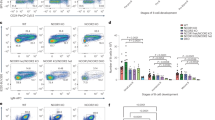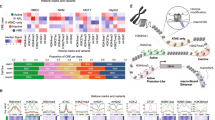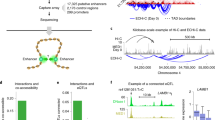Abstract
The transcription factor CCAAT/enhancer binding protein δ (Cebpd, also known as C/EBPδ, CRP3, CELF, NF-IL6β) is implicated in diverse cellular functions such as the acute phase response, adipocyte differentiation, learning and memory, and mammary epithelial cell growth control. Here, we report that lack of Cebpd causes genomic instability and centrosome amplifications in primary embryonic fibroblasts derived from 129S1 mice. Upon spontaneous immortalization, Cebpd-deficient fibroblasts acquire transformed features such as impaired contact inhibition and reduced serum dependence. These data identify a novel role for Cebpd in the maintenance of chromosomal stability and suggest a potential tumor suppressor function in vivo.
This is a preview of subscription content, access via your institution
Access options
Subscribe to this journal
Receive 50 print issues and online access
$259.00 per year
only $5.18 per issue
Buy this article
- Purchase on Springer Link
- Instant access to full article PDF
Prices may be subject to local taxes which are calculated during checkout






Similar content being viewed by others
References
Barone MV, Crozat A, Tabaee A, Philipson L and Ron D . (1994). Genes Dev., 8, 453–464.
Billiard J, Grewal SS, Lukaesko L, Stork PJ and Rotwein P . (2001). J. Biol. Chem., 276, 31238–31246.
Breed DR, Margraf LR, Alcorn JL and Mendelson CR . (1997). Endocrinology, 138, 5527–5534.
Cassel TN, Nordlund-Moller L, Andersson O, Gustafsson JA and Nord M . (2000). Am. J. Respir. Cell Mol. Biol., 22, 469–480.
Charles A, Tang X, Crouch E, Brody JS and Xiao ZX . (2001). J. Cell. Biochem., 83, 414–425.
Chen PL, Riley DJ, Chen Y and Lee WH . (1996a). Genes Dev., 10, 2794–2804.
Chen PL, Riley DJ, Chen-Kiang S and Lee WH . (1996b). Proc. Natl. Acad. Sci. USA, 93, 465–469.
Chinery R, Brockman JA, Dransfield DT and Coffey RJ . (1997). J. Biol. Chem., 272, 30356–30361.
Choy L and Derynck R . (2003). J. Biol. Chem., 278, 9609–9619.
Davisson MT . (1994). Gene, 147, 157–160.
Del Sal G, Ruaro ME, Philipson L and Schneider C . (1992). Cell, 70, 595–607.
Deng C, Zhang P, Harper JW, Elledge SJ and Leder P . (1995). Cell, 82, 675–684.
Doxsey S . (2001). Nat. Rev. Mol. Cell Biol., 2, 688–698.
Duensing S and Munger K . (2001). Biochim. Biophys. Acta, 1471, M81–8.
Evdokiou A and Cowled PA . (1998). Int. J. Cancer, 75, 568–577.
Fornace Jr AJ, Nebert DW, Hollander MC, Luethy JD, Papathanasiou M, Fargnoli J and Holbrook NJ . (1989). Mol. Cell. Biol., 9, 4196–4203.
Fukasawa K, Choi T, Kuriyama R, Rulong S and Vande Woude GF . (1996). Science, 271, 1744–1747.
Ghadimi BM, Sackett DL, Difilippantonio MJ, Schrock E, Neumann T, Jauho A, Auer G and Ried T . (2000). Genes Chromosomes Cancer, 27, 183–190.
Gigliotti AP and DeWille JW . (1998). J. Cell. Physiol., 174, 232–239.
Gigliotti AP and DeWille JW . (1999). Breast Cancer Res. Treat., 58, 57–63.
Gigliotti AP, Johnson PF, Sterneck E and DeWille JW . (2003). Exp. Biol. Med. (Maywood), 228, 278–285.
Glick A, Popescu N, Alexander V, Ueno H, Bottinger E and Yuspa SH . (1999). Proc. Natl. Acad. Sci. USA, 96, 14949–14954.
Hoeijmakers JH . (2001). Nature, 411, 366–374.
Jackson RJ, Adnane J, Coppola D, Cantor A, Sebti SM and Pledger WJ . (2002). Oncogene, 21, 8486–8497.
Jainchill JL, Aaronson SA and Todaro GJ . (1969). J. Virol., 4, 549–553.
Janssen RA and Mier JW . (1997). Mol. Biol. Cell, 8, 897–908.
Johansen LM, Iwama A, Lodie TA, Sasaki K, Felsher DW, Golub TR and Tenen DG . (2001). Mol. Cell. Biol., 21, 3789–3806.
Kreidberg JA and Natoli TA . (2001). Tumor Suppressor Genes in Human Cancer, Fisher DE (ed). Humana Press Inc.: Totowa, NH, pp. 3–28.
Liyanage M, Coleman A, du Manoir S, Veldman T, McCormack S, Dickson RB, Barlow C, Wynshaw-Boris A, Janz S, Wienberg J, Ferguson-Smith MA, Schrock E and Ried T . (1996). Nat. Genet., 14, 312–315.
Montagna C, Andrechek ER, Padilla-Nash H, Muller WJ and Ried T . (2002). Oncogene, 21, 890–898.
O'Rourke JP, Newbound GC, Hutt JA and DeWille J . (1999). J. Biol. Chem., 274, 16582–16589.
Pabst T, Mueller BU, Zhang P, Radomska HS, Narravula S, Schnittger S, Behre G, Hiddemann W and Tenen DG . (2001). Nat. Genet., 27, 263–270.
Palmero I, McConnell B, Parry D, Brookes S, Hara E, Bates S, Jat P and Peters G . (1997). Oncogene, 15, 495–503.
Pantoja C and Serrano M . (1999). Oncogene, 18, 4974–4982.
Piek E and Roberts AB . (2001). Adv. Cancer Res., 83, 1–54.
Ramji DP and Foka P . (2002). Biochem. J., 365, 561–575.
Reitmair AH, Risley R, Bristow RG, Wilson T, Ganesh A, Jang A, Peacock J, Benchimol S, Hill RP, Mak TW, Fishel R and Meuth M . (1997). Cancer Res., 57, 3765–3771.
Ren B, Cam H, Takahashi Y, Volkert T, Terragni J, Young RA and Dynlacht BD . (2002). Genes Dev., 16, 245–256.
Salisbury JL, Whitehead CM, Lingle WL and Barrett SL . (1999). Biol. Cell, 91, 451–460.
Sibilia M and Wagner EF . (1995). Science, 269, 234–238.
Slomiany BA, D'Arigo KL, Kelly MM and Kurtz DT . (2000). Mol. Cell. Biol., 20, 5986–5997.
Sterneck E, Paylor R, Jackson-Lewis V, Libbey M, Przedborski S, Tessarollo L, Crawley JN and Johnson PF . (1998). Proc. Natl. Acad. Sci. USA, 95, 10908–10913.
Sterneck E, Tessarollo L and Johnson PF . (1997). Genes Dev., 11, 2153–2162.
Sugahara K, Sadohara T, Sugita M, Iyama K and Takiguchi M . (1999). Cell Tissue Res., 297, 261–270.
Takiguchi M . (1998). Int. J. Exp. Pathol., 79, 369–391.
Tanaka T, Yoshida N, Kishimoto T and Akira S . (1997). EMBO J., 16, 7432–7443.
Tang QQ and Lane MD . (1999). Genes Dev., 13, 2231–2241.
Tessarollo L . (2001). Methods Mol. Biol., 158, 47–63.
Threadgill DW, Dlugosz AA, Hansen LA, Tennenbaum T, Lichti U, Yee D, LaMantia C, Mourton T, Herrup K, Harris RC, Barnard YA, Yuspa SH, Coffey RY and Magnuson T . (1995). Science, 269, 230–234.
Timchenko NA, Wilde M, Iakova P, Albrecht JH and Darlington GJ . (1999). Nucleic Acids Res., 27, 3621–3630.
Timchenko NA, Wilde M, Nakanishi M, Smith JR and Darlington GJ . (1996). Genes Dev., 10, 804–815.
Todaro G and Green H . (1963). J. Cell Biol., 17, 299–313.
Umayahara Y, Ji C, Centrella M, Rotwein P and McCarthy TL . (1997). J. Biol. Chem., 272, 31793–31800.
Wang H, Goode T, Iakova P, Albrecht JH and Timchenko NA . (2002). EMBO J., 21, 930–941.
Wang H, Iakova P, Wilde M, Welm A, Goode T, Roesler WJ and Timchenko NA . (2001). Mol. Cell, 8, 817–828.
Welm AL, Timchenko NA, Ono Y, Sorimachi H, Radomska HS, Tenen DG, Lekstrom-Himes J and Darlington GJ . (2002). J. Biol. Chem., 277, 33848–33856.
Xu X, Weaver Z, Linke SP, Li C, Gotay J, Wang XW, Harris CC, Ried T and Deng CX . (1999). Mol. Cell, 3, 389–395.
Zahnow CA, Cardiff RD, Laucirica R, Medina D and Rosen JM . (2001). Cancer Res., 61, 261–269.
Zhang S, Ramsay ES and Mock BA . (1998). Proc. Natl. Acad. Sci. USA, 95, 2429–2434.
Zhang SL, DuBois W, Ramsay ES, Bliskovski V, Morse III HC, Taddesse-Heath L, Vass WC, DePinho RA and Mock BA . (2001). Mol. Cell. Biol., 21, 310–318.
Zhu S, Yoon K, Sterneck E, Johnson PF and Smart RC . (2002). Proc. Natl. Acad. Sci. USA, 99, 207–212.
Zinszner H, Kuroda M, Wang X, Batchvarova N, Lightfoot RT, Remotti H, Stevens JL and Ron D . (1998). Genes Dev., 12, 982–995.
Acknowledgements
We thank Mary Beth Hilton, Barbara Shankle and Lori Warg for expert technical assistance, and Danny Wangsa for help with mouse SKY kits preparation. We thank David Ron, J.L. Salisbury, Claudio Schneider, Richard Janssen and Debbie Morrison for valuable reagents and advice; Karen Vousden's laboratory for generous support with resources and expert advice; Karen Vousden, Shyam Sharan and Lino Tessarollo for critical reading of the manuscript.
Author information
Authors and Affiliations
Corresponding author
Rights and permissions
About this article
Cite this article
Huang, AM., Montagna, C., Sharan, S. et al. Loss of CCAAT/enhancer binding protein δ promotes chromosomal instability. Oncogene 23, 1549–1557 (2004). https://doi.org/10.1038/sj.onc.1207285
Received:
Revised:
Accepted:
Published:
Issue Date:
DOI: https://doi.org/10.1038/sj.onc.1207285
Keywords
This article is cited by
-
C/EBPδ protects from radiation-induced intestinal injury and sepsis by suppression of inflammatory and nitrosative stress
Scientific Reports (2019)
-
HIF-1A and C/EBPs transcriptionally regulate adipogenic differentiation of bone marrow-derived MSCs in hypoxia
Stem Cell Research & Therapy (2015)
-
Inflammation and hypoxia linked to renal injury by CCAAT/enhancer-binding protein δ
Kidney International (2015)
-
The CCAAT/enhancer-binding protein δ (C/EBP-δ) transcription factor is heat inducible in the cold-adapted antarctic fish Trematomus bernacchii
Polar Biology (2013)
-
GeneFriends: An online co-expression analysis tool to identify novel gene targets for aging and complex diseases
BMC Genomics (2012)



